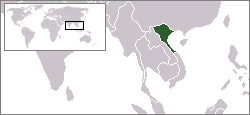North Vietnam
|
|||||||||||||||||||||||||||||||||||
| History of Vietnam | ||||||||||||||||||||||||||||||||||||||||||||||||||||||||||||||||||||||||||||||||||||||||||||
|---|---|---|---|---|---|---|---|---|---|---|---|---|---|---|---|---|---|---|---|---|---|---|---|---|---|---|---|---|---|---|---|---|---|---|---|---|---|---|---|---|---|---|---|---|---|---|---|---|---|---|---|---|---|---|---|---|---|---|---|---|---|---|---|---|---|---|---|---|---|---|---|---|---|---|---|---|---|---|---|---|---|---|---|---|---|---|---|---|---|---|---|---|
|
||||||||||||||||||||||||||||||||||||||||||||||||||||||||||||||||||||||||||||||||||||||||||||
The Democratic Republic of Vietnam (DRVN), or less commonly, Vietnamese Democratic Republic (Vietnamese: Việt Nam Dân Chủ Cộng Hòa) was an effective state all over Vietnam from 1945 until the partition of Vietnam in 1954. From 1954 to 1976, it is referred to as a country on the northern half of Vietnam. It was proclaimed by Hồ Chí Minh in Hà Nội on September 2, 1945 with The Declaration of Independence, following the nation-wide August Revolution, as a communist provisional government.
On January 1, 1946, the first general election of Vietnam was held all over the country. The National Assembly was established with 333 elected deputies. The first National Assembly's session on March 2, 1946 in Hà Nội approved Ho Chi Minh as the head of the Government, and former-Emperor Bảo Đại as the Supreme-Advisor. The National Assembly also passed the Constitution of the Democratic Republic of Vietnam on November 11, 1946.
North Vietnam and the National Front for the Liberation of South Vietnam won the Second Indochina War, which is referred to outside the region as the "Vietnam Conflict", the "War in Viet Nam" , or more simply, "Vietnam War". The Government of the Democratic Republic of Vietnam controlled North Vietnam after the temporary partition of Vietnam in accordance with the Geneva Accords (1954). As the Government of South Vietnam refused to join the general election, which was indicated by the Geneva Accords to be organized in 1956 to re-unify the country, the partition of Vietnam continued until 1975. The Government of North Vietnam and the National Front for the Liberation of South Vietnam took over South Vietnam, leading to the united larger Vietnam that exists today with the same political system and organization as those of the North.
Contents |
Partition of Indochina
- Further information: First Indochina War, Operation Passage to Freedom, and Geneva Conference (1954)
Following the partition of Vietnam in 1954 at the end of the First Indochina War, thousands of Vietnamese migrated to either the North and to the South. For example, an estimated 800,000 Catholics moved south. [1] The Catholic migration is attributed to perceived persecution of Catholics by the North Vietnamese government, as well as scare campaigns employed by the Saigon government of the Catholic Ngo Dinh Diem. [2] Concurrently, an estimated 130,000 people from South Việtnam who supported the Viet Minh headed for the North with the aid of Polish and Soviet ships.[3]
Between 1953 and 1956, the DRVN government instituted various agrarian reforms, including land redistribution. Large landowners were publicly denounced as landlords (địa chủ), and their land distributed to poor and middle peasants.
A literary movement called Nhân văn-Giai phẩm (from the names of the two magazines which started the movement) attempted to encourage the democratization of the country and the free expression of thought.
International relations
The Democratic Republic of Vietnam (North Vietnam) capital was Hà Nội and its government was led by the left-nationalist Vietnam Workers' Party, which had been formed in opposition to foreign (French and Japanese) involvement in the territory of Vietnam.
In December 1960, the Vietnam Workers' Party co-initiated and began working within the National Liberation Front of South Vietnam (referred to by the South as the Việt Cộng) which was organized to support reunification and oppose the government of South Vietnam. After August 1964, this was expanded to armed opposition to the military presence and operations of the United States in the southern areas of Vietnam.[4] From at least 1965 onwards, both China and the Soviet Union provided aid to North Vietnam in support of its military activities; known in the West as the Vietnam War and in Vietnam as the American War.
In June 1969, in the South, the NLF formed a Provisional Revolutionary Government in order to present an organized alternative government to the international community.[5]
In addition to the NLF, other nationalist insurgencies also operated within neighboring Laos and Cambodia, both formerly part of the French colonial territory of Indochina.
The Fall of Saigon

With the fall of Saigon to National Liberation Front and regular North Vietnamese armed forces on April 30, 1975, political authority within South Vietnam was assumed by the Provisional Revolutionary Government of the Republic of South Vietnam (Chính phủ cách mạng lâm thời nước Cộng hoà miền Nam Việt Nam). This government merged with Democratic Republic of Vietnam on July 2, 1976, to form a single nation officially called the Socialist Republic of Vietnam (Cộng hoà xã hội chủ nghĩa Việt Nam), or more commonly known as Việt Nam.
References
- ↑ United Nations High Commission on Refugees. 2000. The State of the World's Refugees 2000: Fifty Years of Humanitarian Action. Oxford University Press. from.
- ↑ Truong Nhu Tang. 1986. A Viet Cong Memoir. Vintage.
- ↑ United Nations High Commission on Refugees. 2000. The State of the World's Refugees 2000: Fifty Years of Humanitarian Action. Oxford University Press. from.
- ↑ Truong Nhu Tang. 1986. A Viet Cong Memoir. Vintage.
- ↑ Truong Nhu Tang. 1986. A Viet Cong Memoir. Vintage.
See also
- August Revolution
- Vietnam
- Flag of North Vietnam
- South Vietnam
- Indochina Wars
- Hồ Chí Minh
- Socialist State
- People's Army of Vietnam
- Northern and southern Vietnam
External links
| Preceded by Nguyễn Dynasty Empire of Vietnam |
Ruler of North Vietnam 1945 - 1976 |
Succeeded by Socialist Republic of Vietnam |

